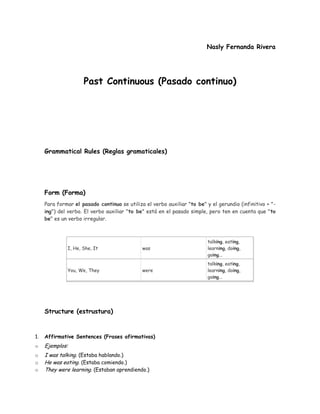
Past Continuous Tense Guide
- 1. Nasly Fernanda Rivera Past Continuous (Pasado continuo) Grammatical Rules (Reglas gramaticales) Form (Forma) Para formar el pasado continuo se utiliza el verbo auxiliar "to be" y el gerundio (infinitivo + "- ing") del verbo. El verbo auxiliar "to be" está en el pasado simple, pero ten en cuenta que "to be" es un verbo irregular. talking, eating, I, He, She, It was learning, doing, going... talking, eating, You, We, They were learning, doing, going... Structure (estrustura) 1. Affirmative Sentences (Frases afirmativas) o Ejemplos: o I was talking. (Estaba hablando.) o He was eating. (Estaba comiendo.) o They were learning. (Estaban aprendiendo.)
- 2. EstructuraSujeto + verbo auxiliar ("to be") + gerundio. 2. Negative Sentences (Frases negativas) o Ejemplos: o I was not [wasn't] talking. (No estaba hablando.) o He was not [wasn't] eating. (No estaba comiendo.) o They were not [weren't] learning. (No estaban aprendiendo.) EstructuraSujeto + verbo auxiliar ("to be") + "not" + gerundio. 3. Interrogative Sentences (Frases interrogativas) o Ejemplos: o Were you talking? (¿Estabas hablando?) o Was he eating? (¿Estaba comiendo?) o Were they learning? (¿Estaban aprendiendo?) EstructuraVerbo auxiliar ("to be") + sujeto + gerundio. Uses (uso) 1. El pasado continuo lo utilizamos para una acción larga que ya en el pasado fue interrumpido. La acción que se interrumpe está en pasado continuo y la acción que provoca la interrupción está en pasado simple. "When" y "while" señalan el uso del pasado simple y continuo. En general, usamos el pasado simple directamente después de "when" y el pasado continuo después de "while." o Ejemplos: o Jose called while I was watching the news. (Jose llamó mientras estaba mirando las noticias.) o He was walking to work when he fell. (Estaba caminando hacia su trabajo cuando se cayó.) o Was it raining when you left? (¿Estaba lloviendo cuando te fuiste?) 2. Se usa el pasado continuo para hablar sobre acciones en un tiempo específico en el pasado. o Ejemplos o Paula wasn't living in Spain in 2005. (Paula no estaba viviendo en España en el 2005.) o We were still working at 10 o'clock last night. (Todavía estabamos trabajando a las 10 de la noche. ) 3. Se usa el pasado continuo para dos acciones que estaban ocurriendo al mismo tiempo en el pasado. o Ejemplos o My son was reading while I was cooking. (Mi hijo estaba leyendo mientras que yo estaba cocinando.)
- 3. o They were talking very loudly while we were trying to watch the movie. (Estaban hablando muy alto mientras nosotros estábamos intentando mirar la pelicula.) Exercise continuous . Affirmative I (have) was having my breakfast when you called. They (watch) were watching TV when I arrived. While he (read) was reading the newspaper, the dog ate his dinner. While you (do) were doing your homework, I made you a cake. Negative You (not listen) weren’t listening when the teacher told us what to do. My dad (not watch) wasn’t watching when I scored a goal. They (not wait) weren’t waiting at the airport when I arrived. I (not be rude) wasn’t being rude when I left the party early. Questions Where (they/go) were they going when you saw them? (You/watch) were you watching friends when I called? What (you/think about) were you thinking when you started to laugh? (He/wear) he was wearing that big hat when you saw him?